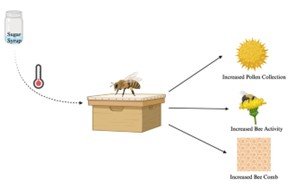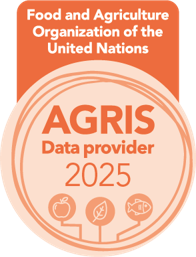Optimum sugar syrup feeding intervals for Apis cerana Fab. during the winter dearth period in the sub-tropical area of Nepal
Abstract
The study aimed to identify the optimal sugar syrup feeding interval for honeybee colonies during the winter dearth period in subtropical region of Nepal to ensure colony survival and maintenance. The focus was on evaluating sealed brood area, sealed honey area, egg-laying activity, and pollen collection. The experiment was conducted in an apiary located in Lamjung district of Nepal. Sugar syrup (1 water: 1 sugar) was fed to honeybee colonies at intervals of 7, 10, 15, and 20-days, along with a control group. Each treatment was replicated across four replications with five beehives in each replication, and data were collected weekly. Parameters such as the sealed brood area, honey storage, egg-laying rate, and pollen cells were measured by counting eggs, pollen cells, and assessing areas covered by sealed brood and honey. Colonies fed sugar syrup at 15-days intervals exhibited the best performance across all measured parameters, including the largest sealed brood area, highest honey reserves, maximum eggs laid by the queen bee, and the most pollen cells. These results indicate that feeding at 15-days intervals supports optimal colony health and activity during low-temperature winter conditions. Feeding sugar syrup at 15-days intervals is the most effective practice for maintaining colony health, ensuring optimal honey reserves, brood production, and pollen collection during the winter dearth period in subtropical areas of Nepal. This feeding strategy is recommended for improving colony survival, maintenance, and overall performance during challenging winter conditions in subtropical region of Nepal.
Keywords:
Apis cerana, Artificial feeding, Feeding interval, Sugar syrup, Winter dearthDownloads
References
Ahmad, S., Khan, K. A., Khan, S. A., Ghramh, H. A., & Gul, A. (2021). Comparative assessment of various supplementary diets on commercial honey bee (Apis mellifera) health and colony performance. PLoS ONE, 16(10), 1–11. https://doi.org/10.1371/journal.pone.0258430
Alburaki, M., Madella, S., & Cook, S. C. (2023). Non-optimal ambient temperatures aggravate insecticide toxicity and affect honey bees Apis mellifera L. gene regulation. Scientific Reports, 13(1), 1–15. https://doi.org/10.1038/s41598-023-30264-0
Amera, W. A., Mersso, B. T., Sisay, T. A., Arega, A. B., & Alene, A. T. (2024). Effect of various supplements on productive performance of honey bees, in the south Wollo Zone, Ethiopia. PLoS ONE, 19(5), 1–16. https://doi.org/10.1371/journal.pone.0303579
Aryal, L. N., Thapa, R. B., Tiwari, S., & Chaudhary, N. K. (2016). Foraging behavior of native honeybee (Apis cerana F.) and European honeybee (Apis mellifera L.) on flowers of common buckwheat (Fagopyrum esculentum M.) in Chitwan, Nepal. International Journal of Applied Sciences and Biotechnology, 4(2),
-239. https://doi.org/10.3126/ijasbt.v4i2.15131
Avni, D., Dag, A., & Shafir, S. (2009). The effect of surface area of pollen patties fed to honey bee (Apis mellifera) colonies on their consumption, brood production and honey yields. Journal of Apicultural Research, 48(1), 23–28. https://doi.org/10.3896/IBRA.1.48.1.06
Brodschneider, R., & Crailsheim, K. (2010). Nutrition and health in honey bees. Apidologie, 41(3), 278–294. https://doi.org/10.1051/apido/2010012
Banjade, D., Dahal, B., Khanal, D., & Shrestha, A. (2024). Role of Apis laboriosa bees for the himalayan biodiversity conservation and their potential conservation efforts. Tropical Agrobiodiversity, 5(2), 76-80). https://doi.org/10.26480/trab.02.2024.76.80
Bastakoti, B., & Khanal, D. (2022). Organic farming: a feasible solution to agricultural sustainability: A detailed review. INWASCON Technology Magazine, 4, 25–27. https://doi.org/10.26480/itechmag.04.2022.25.27
de Oliveira, G. P., Kadri, S. M., Emilio Benaglia, B. G., Martins Ribolla, P. E., & Orsi, R. de O. (2020). Energetic supplementation for maintenance or development of Apis mellifera L. colonies. Journal of Venomous Animals and Toxins Including Tropical Diseases, 26, 1–8. https://doi.org/10.1590/1678-9199-JVATITD-2020-0004
Estravis-Barcala, M. C., Palottini, F., Verellen, F., González, A., & Farina, W. M. (2024). Sugar-conditioned honey bees can be biased towards a nectarless dioecious crop. Scientific Reports, 14(1), 1–11. https://doi.org/10.1038/s41598-024-67917-7
Gemeda, T. K., Li, J., Luo, S., Yang, H., Jin, T., Huang, J., & Wu, J. (2018). Pollen trapping and sugar syrup feeding of honey bee (Hymenoptera: Apidae) enhance pollen collection of less preferred flowers. PLoS ONE, 13(9), 1–14. https://doi.org/10.1371/journal.pone.0203648
Ji, C., Shi, W., Tang, J., Ji, T., Gao, J., Liu, F., Shan, J., Chen, X., & Chen, C. (2023). Morphometrical analyses revealed high diversity of the eastern honey bee (Apis cerana) in mountains and islands in China. Journal of Apicultural Research, 62(4), 647–655. https://doi.org/10.1080/00218839.2023.2205670
Kim, H., Frunze, O., Maigoro, A. Y., Lee, M. L., Lee, J. H., & Kwon, H. W. (2024). Comparative Study of the Effect of Pollen Substitute Diets on Honey Bees during Early Spring. Insects, 15(2). https://doi.org/10.3390/insects15020101
Kumar, R., & Mall, P. (2018). Important traits for the selection of honey bee (Apis mellifera L.) colonies. Journal of Entomology and Zoology Studies, 6(3), 906–909.
Liu, A. F., Zhang, X., Chai, J., Yang, D., & Zhang, F. L. X. (2020). Pollen phenolics and regulation of pollen foraging in honeybee colony. Behavioral Ecology and Sociobiology, 59(4), 582–588. https://doi.org/10.3007/s00265-005-0084-x
Naveen, Yadav, A. S., Singh, U., & Tomar, S. (2024). Consumption of different artificial diets by Apis mellifera L. colonies during dearth period in Morena, M.P., India. Uttar Pradesh Journal of Zoology, 45(15), 379–386. https://doi.org/10.56557/upjoz/2024/v45i154254
Peirson, M., Ibrahim, A., Ovinge, L. P., Hoover, S. E., Guarna, M. M., Melathopoulos, A., & Pernal, S. F. (2024). The effects of protein supplementation, fumagillin treatment, and colony management on the productivity and longterm survival of honey bee (Apis mellifera) colonies. PLoS ONE, 19(3), 1–21. https://doi.org/10.1371/journal.pone.0288953
Prakash, S., Tomar, S., & Singh, Y. P. (2014). Effect of Sugar solution feeding as an artificial diet on colonies of Apis mellifera L. In relation to survival and storage during Dearth period. Journal of Entomology and Zoology Studies, 2(4), 265–267.
Sultana, N., Reza, M. E., Alam, M. N., Siddiquee, M. N. A., Islam, M. S., Rahman, M. A., Sayed, M. A., & Rahman, M. M. (2024). Evaluating the efficiency of supplementary feeding as a management strategy for enhancing honeybee (Apis mellifera L.) colony growth and productivity. Frontiers in Bee Science, 2, 1–12. https://doi.org/10.3389/frbee.2024.1386799
Vijayakumari, N., Saravanan, P. A., Chitra, N., & Rajendran, L. (2022). Effect of supplementary sugar feeding on colony growth of Asiatic hive bee, Apis cerana indica F. Journal of Applied and Natural Science, 14, 220–226. https://doi.org/10.31018/jans.v14iSI.3612
Zhang, C., Pokhrel, S., Wu, Z., Miao, X., Huang, Z. Y., & Yang, W. (2019). Longevity, food consumption, and foraging performance of Apis cerana and Apis mellifera in mixed colonies. Apidologie, 50(2), 153–162. https://doi.org/10.1007/s13592-018-0626-7

Published
How to Cite
Issue
Section
Copyright (c) 2024 Agriculture and Environmental Science Academy

This work is licensed under a Creative Commons Attribution-NonCommercial 4.0 International License.

